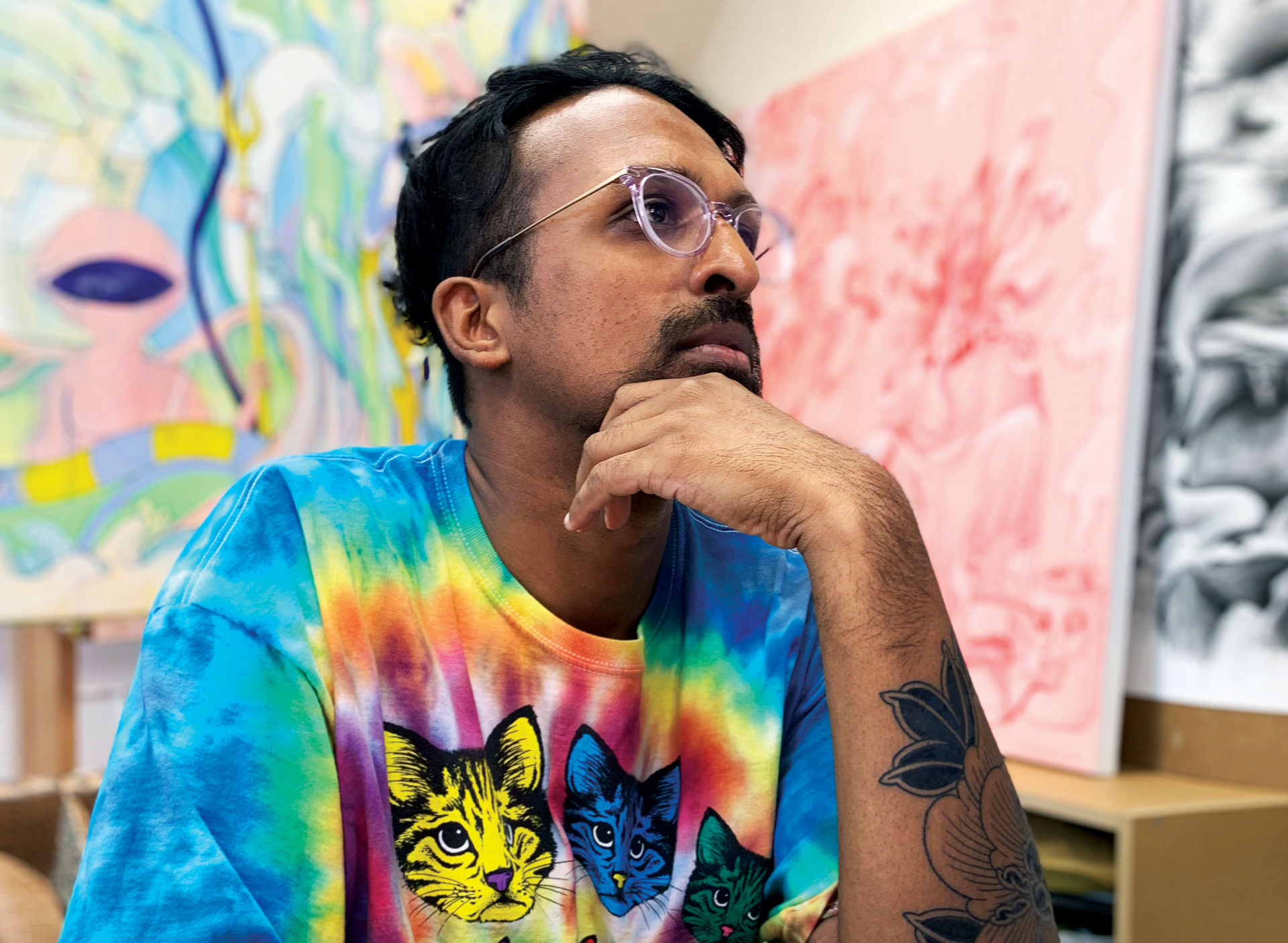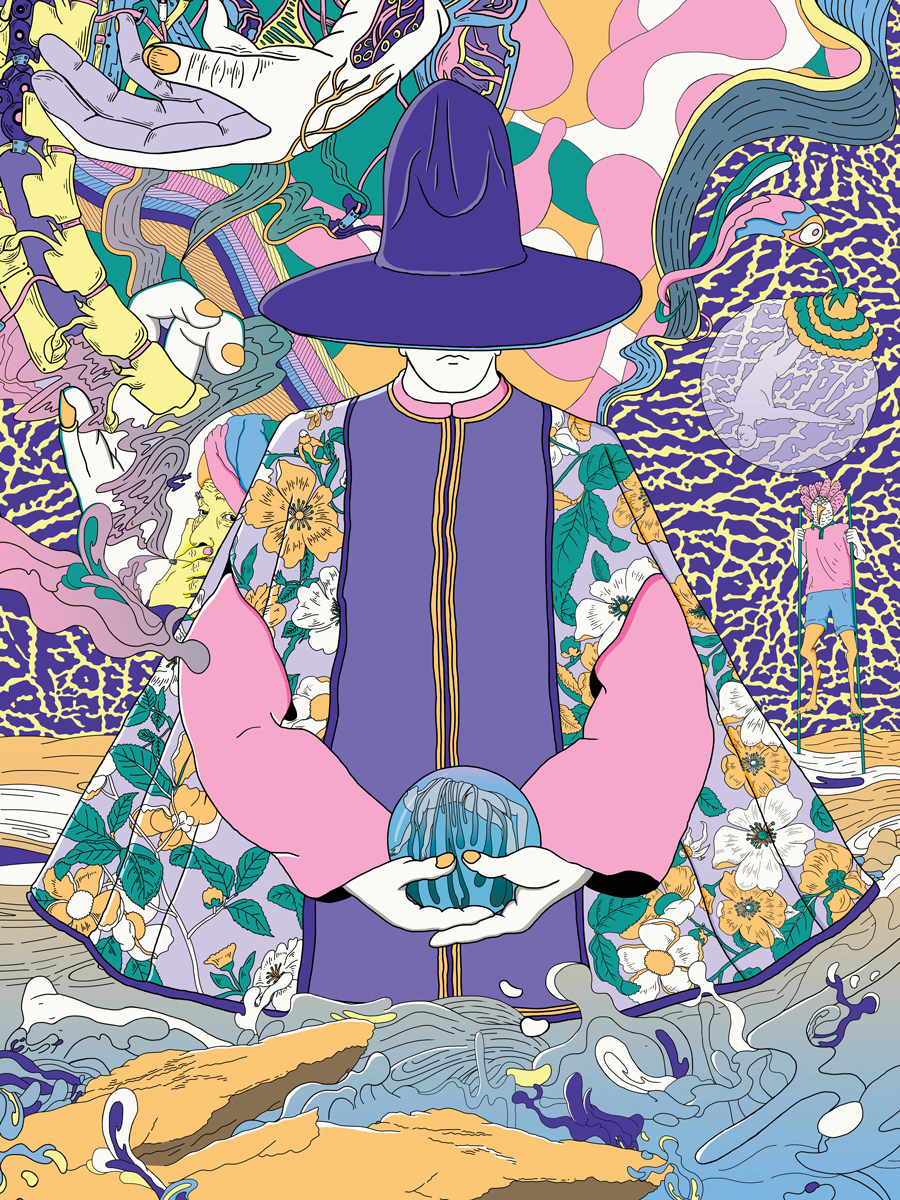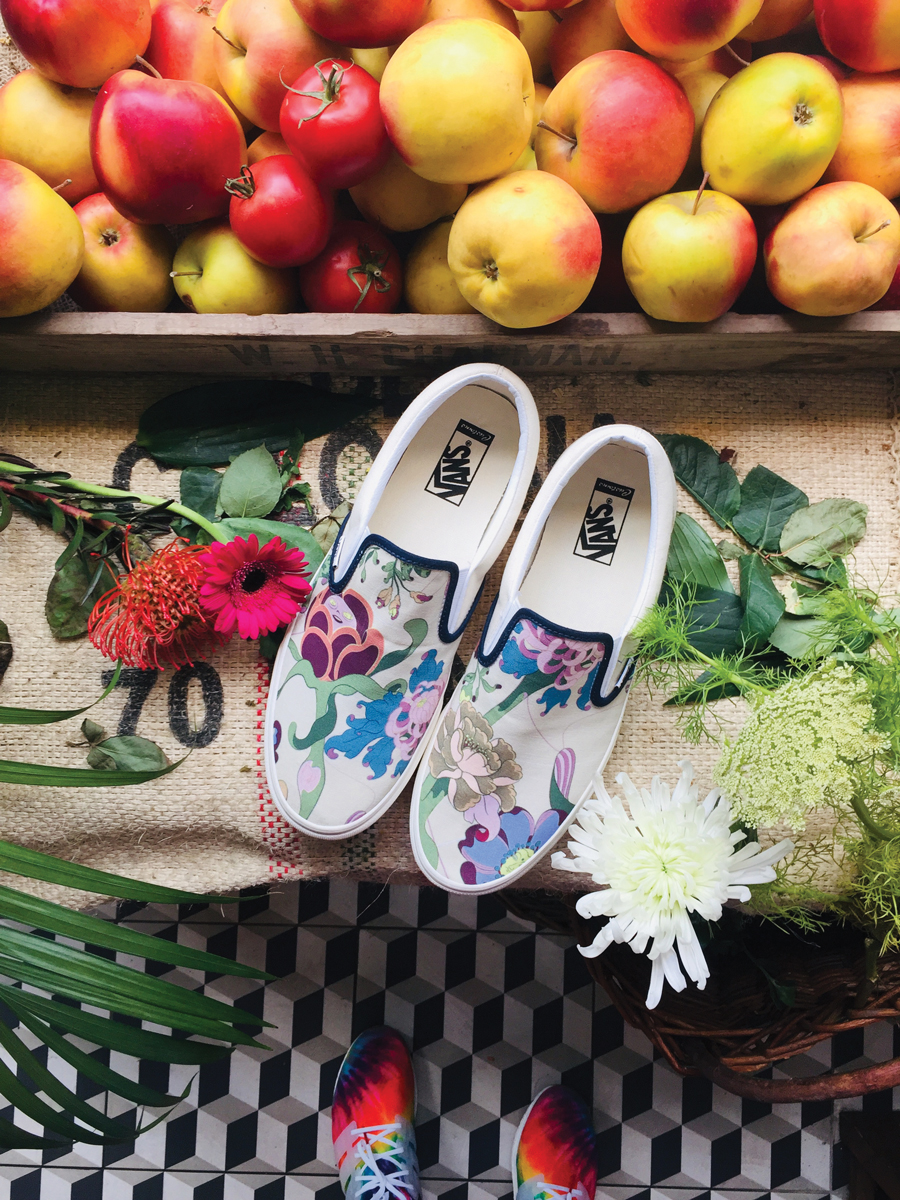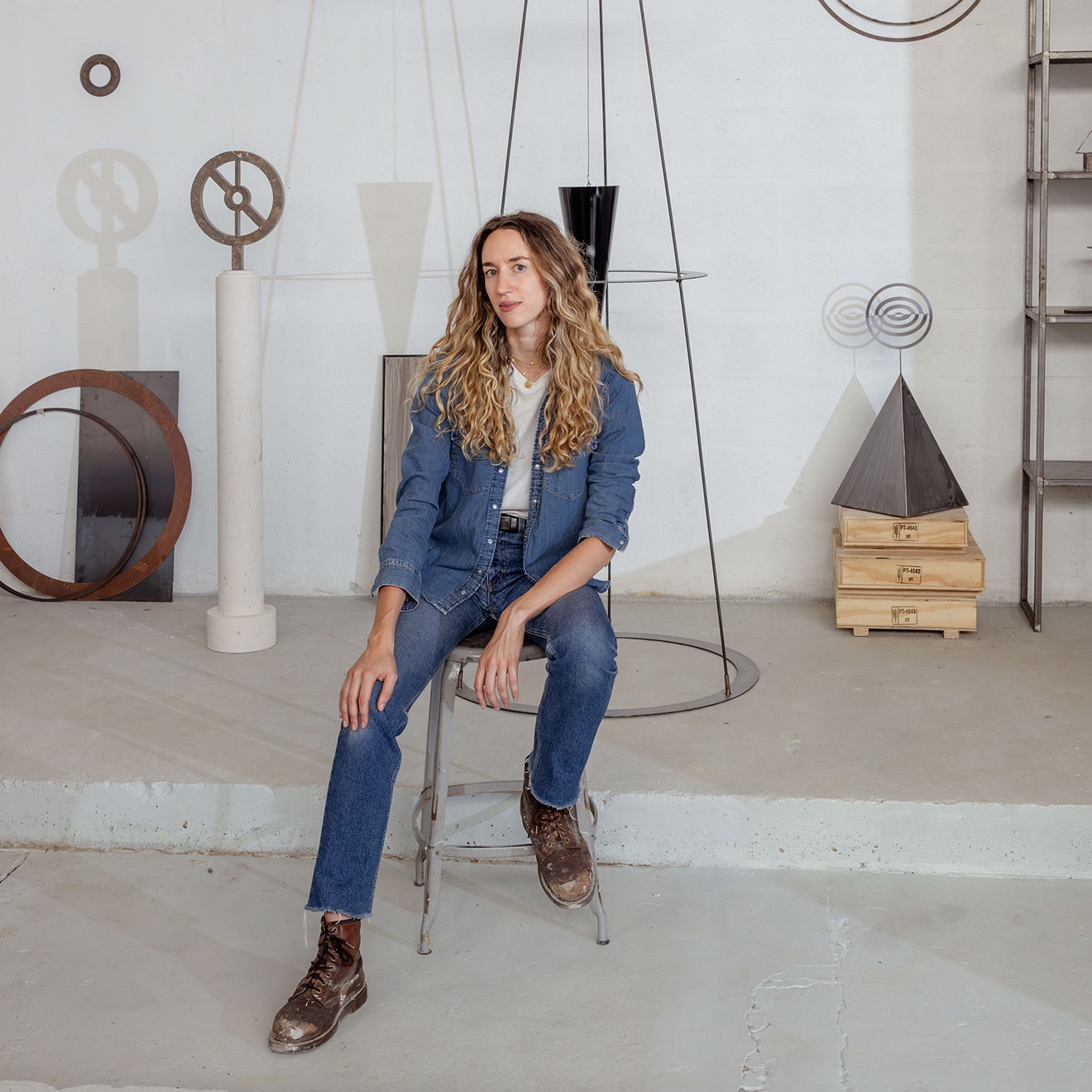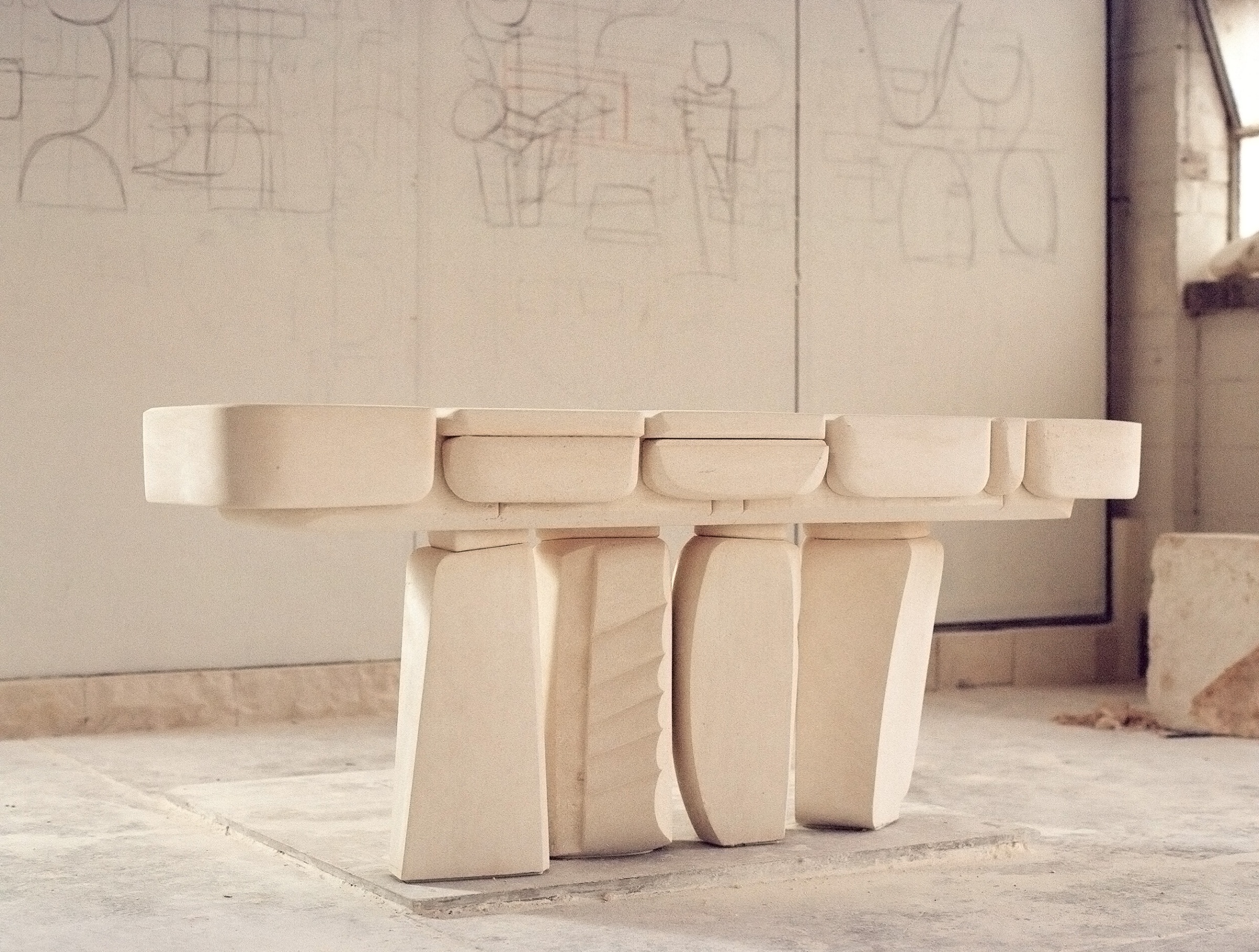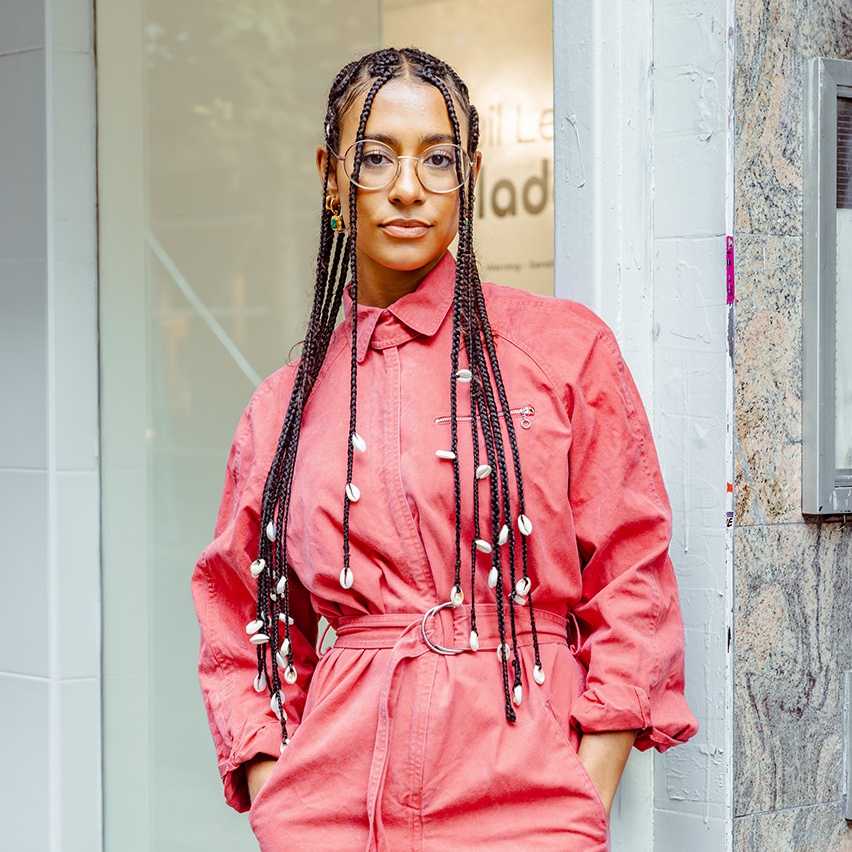When it’s nice out, Sharm Murugiah bikes or runs the six or seven miles to his studio in a 19th century library building in southeast London.
He calls the neighborhood a “leafy part of London,” about a 20-minute train trek from the Shard; it’s a place where Sharm, known professionally as MURUGIAH (one word, like Madonna, he laughs) works with like-minded artists, bouncing ideas off of two other illustrators, an animator, and a radio producer who share his space.
But this wasn’t always MURUGIAH’s life. Now 31, he trained as an architect and tried to make that life work for almost a decade before admitting it wasn’t right and quitting to freelance as an illustrator full-time. His work has evolved, but he’s perhaps most known for his surreal, cartoon style. “The first few years were very up and down in terms of getting projects, but you do enough personal work and knock on as many doors as possible and eventually things grow and build from there,” he says. Today MURUGIAH has worked with everyone from Nike and Vans to Apple, Disney, and Lucasfilm. He recently collaborated with Netflix as part of a Stranger Things book and, from the sounds of our recent conversation, has even bigger projects up his sleeve and on the horizon to be announced soon.
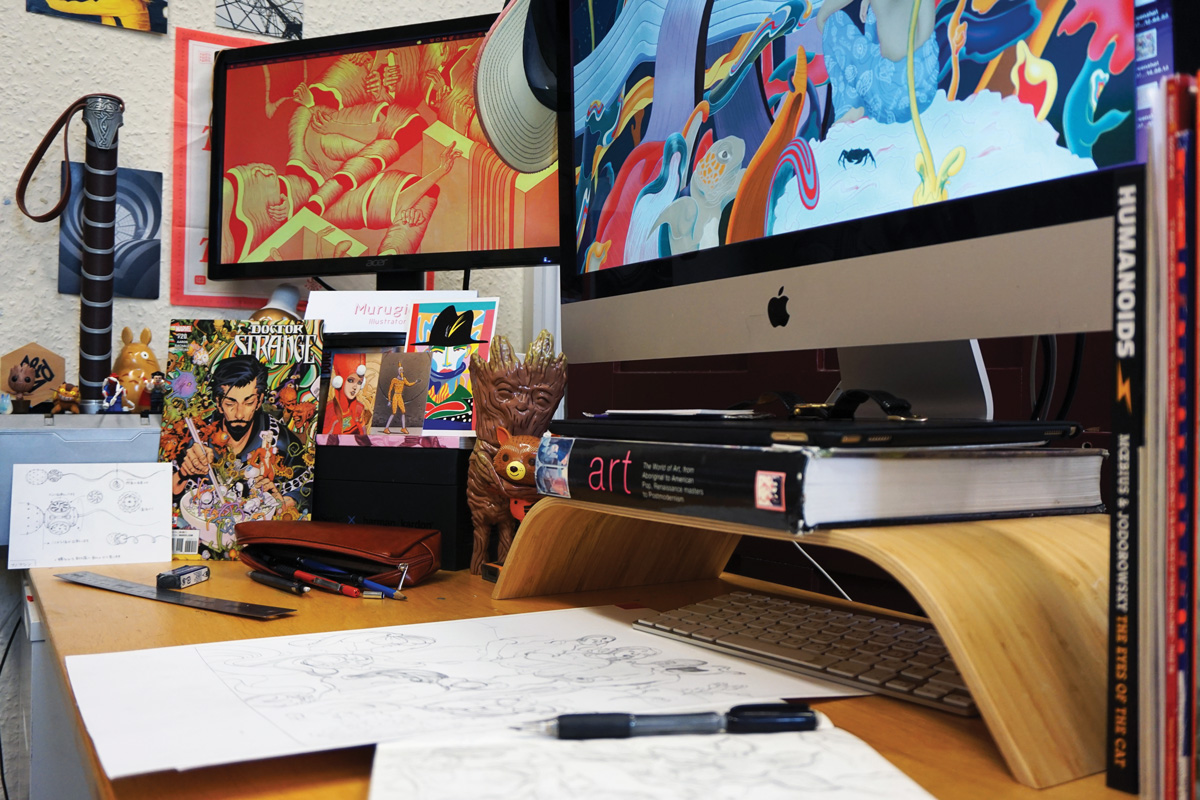
Photo by Geo Law
Talk to me about where and how you work. What does that look like these days?
I had a studio at home for the first few years of my career, in the spare room of my apartment I share with my girlfriend and two cats. It got really depressing because I was working there on my own and not really seeing many people. I would wake up in my pajamas and go straight to work, and I gained lots of weight and it wasn’t very healthy at all. It may change later on where I do have a home studio and I have a much more rigorous exercise regime or way of separating myself from work, but most of my work now is done in the new studio space. When I’m home I try to relax. I try. I took a day off today purely because I’m packing for a wedding in Germany tomorrow.
But you’re still doing an interview.
I’m still doing an interview. I’ve still got sketches. I did watch a film for inspiration today. It’s very hard for me to relax, my girlfriend will tell me on a regular basis.
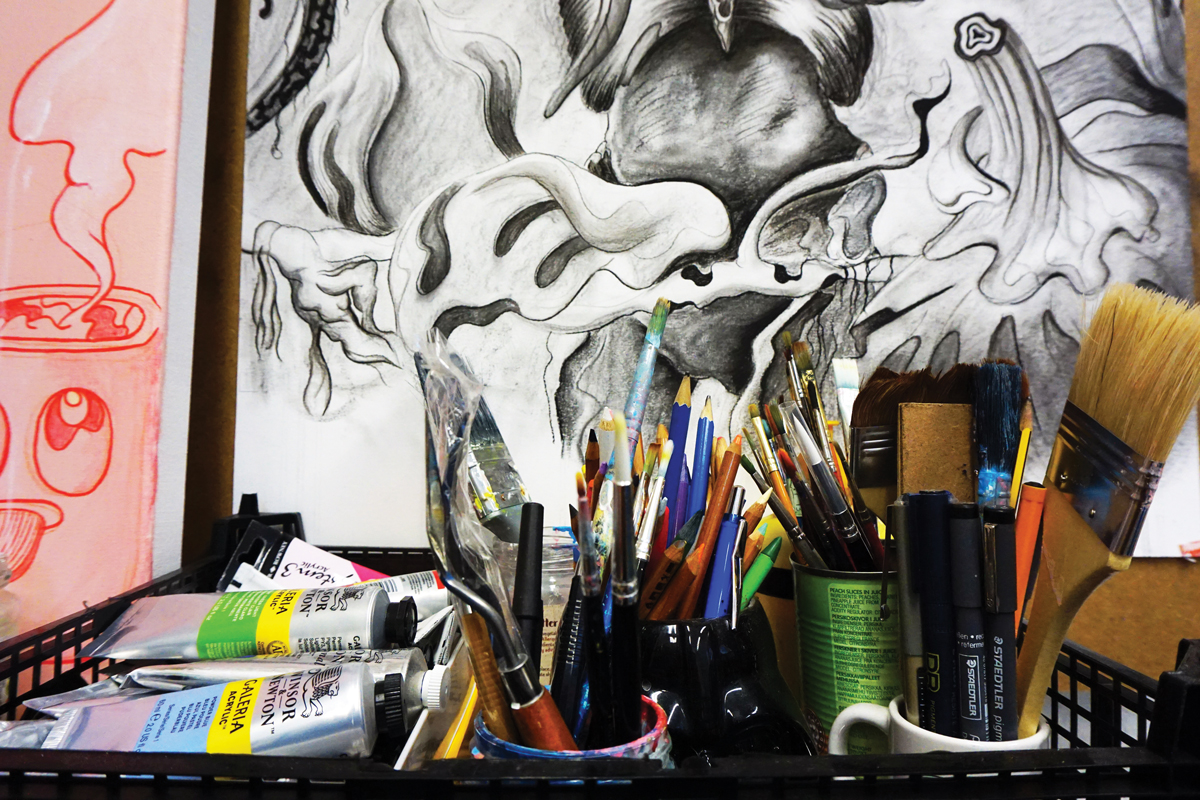
Photo by Geo Law
Speaking of being a workaholic, how would you
define success?
Some people look at financial success or they look at success in terms of clients they particularly want to work with. I have looked at success in those ways. But success has already been made. It’s being able to work in an industry I love, being able to draw every day and be financially stable with it. I think that’s success and if I can keep doing that for my entire career then I’d be more than happy. But it has taken me quite a long time to get to that place; only a few months ago success would have meant a different thing. I think it would be about who I got to work with. You should really be defined by the work you produce on your own, and if you can produce amazing work on your own then you get those clients coming to you anyway. That’s how I look at success now. It’s being very happy. It’s living with my girlfriend and being able to draw and paint as I see fit.
“You should really be defined by the work you produce on your own, then you get those clients coming to you anyway.”
How did you get started as an illustrator? Why make the switch from architecture?
I asked my parents at the age of 18 if I could be an artist and they said no. If you know anything about South Asian parents they’re generally very strict in terms of career choices for their kids. They immigrated to the UK when they were in their 30s. If you’re growing up in Sri Lanka as a young kid, being my mom and dad, the route to take out of the country was through a field of work they recognized; I think that was medicine for them. They tried to get me to do engineering or law or medicine; they didn’t understand art and design. Long story short, they said find a job that gives you a 9 to 5 that still has an element of creativity, which led me to architecture. It was a long seven years of training as an architect and a couple years practicing as well before that fine art and illustration love pushed its way through.
Throughout my architecture course I was designing building projects that were art-related. I ended up doing a couple of gallery building projects as part of my course; my final year we had to design an art gallery in Berlin. My architecture teacher told me my building was beautifully designed … I had done so much work presenting it. We had to produce these handbound printed books, and he told me they were amazing but that the building was not very well thought out in its construction. He said, “You would be far better off as a graphic designer or illustrator because I can see your lack of interest in the bare bones of the architecture stuff.” That was the final push to say, “OK. Maybe I’m in the wrong profession.” I did try working, I worked for I think a year-and-a-half before I got stress-induced alopecia from being in the wrong profession. I called my mum up and I said, “Look. I’m having some real trouble here. I don’t think I’m in the right job.” She said I should do what made me happy, and the rest would figure itself out. I wish she had told me that when I was 18, but I think everything happens for a reason. And that’s what led me into the illustration world.
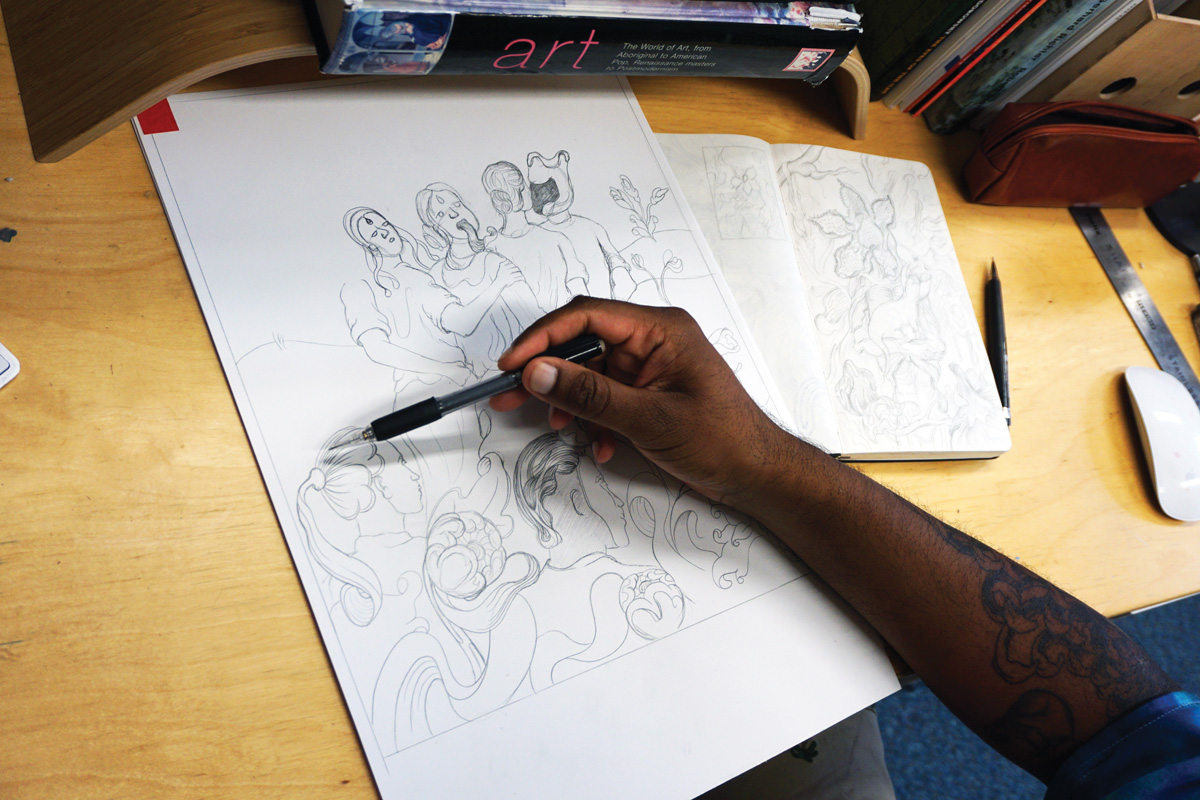
Photo by Geo Law
What have you been working on most recently?
I have a couple of projects I can’t talk about as I’ve signed NDAs, but for one of them I’m getting to potentially work with a very famous illustrator. He’s a legend in British illustration and has worked with one of the biggest bands in the world. I’ve been commissioned to work with Earthsite, a charity I’ve worked with before producing an editorial illustration. I’ve got an image in a book coming out in October—Visions from the Upside Down; it’s a Stranger Things netflix collaboration. The publisher is Printed in Blood, and it’s a coffee table book filled with various artists (Bill Sienkiewicz, Orlando Arocena, and others). I’ve produced a charcoal drawing I scanned in and colored digitally. I saw it as an opportunity to make something quite special because I normally work digitally, but I’ve got a mixture of mediums now that I’m very happy about. Those are the more commercial projects I’m doing. The rest are personal—paintings, drawings, canvas paintings, and digital paintings of my more surreal ideas. I think the best work is generated from your personal work. Clients tend to see the personal work you do and see something they want in their own brand. So I’m nearly a fine artist. [Laughs] I mean I’m not at that point where I’m making paintings and selling them, but I’ve always wanted to be on the commercial side as well as the fine arts side. I never wanted to go fully into the fine art world. I think there are more opportunities to work with commercial brands, especially if a brand sees you for who you are, sees your body of work
being really weird and surreal and says, “Can you do some of that for us?” That’s where I want to be.
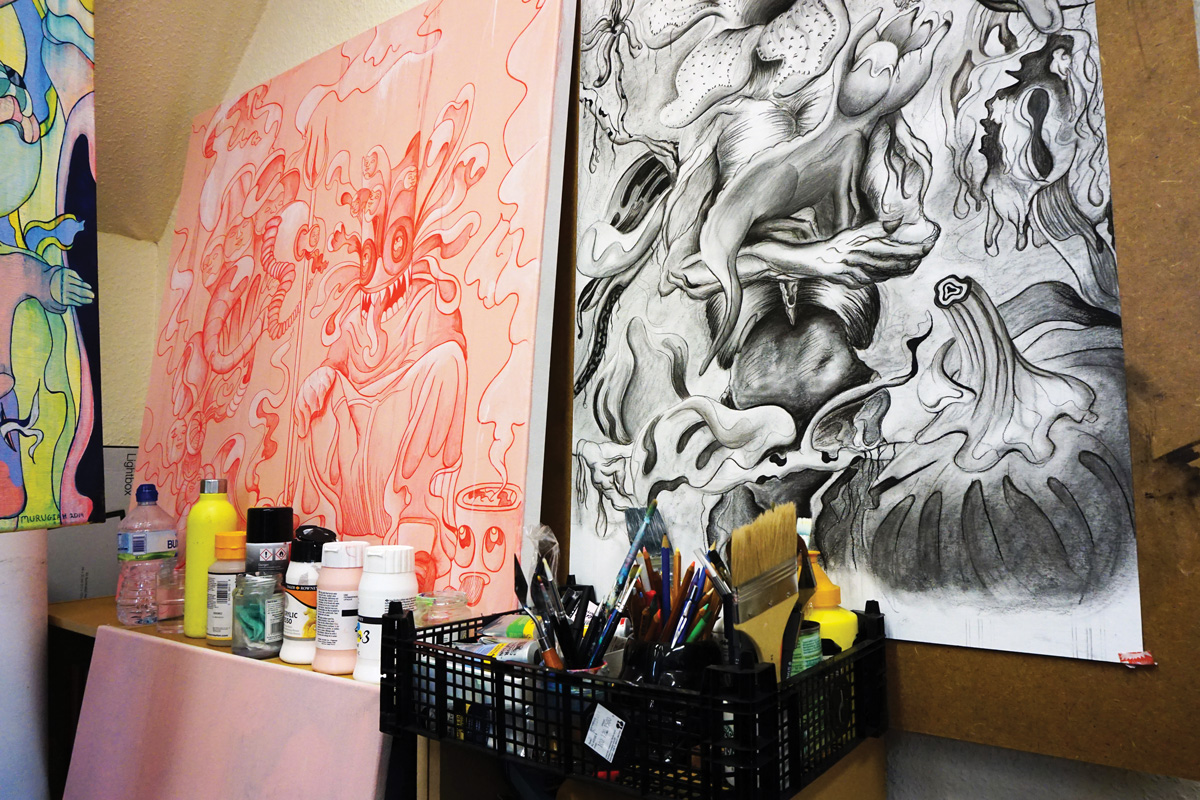
The painting pictured on the left, called “Many Faces,” explores identity. “The painting explores the many faces I have worn during different phases in my life.” Photo by Geo Law
Is there a brand who has “gotten it” and approached you?
Examples are projects that are currently in negotiation. It takes quite a few years to build that world and that way of working before a brand can really trust you, I think. And I had a very different style until about a year-and-a-half ago. My style was a “Where’s Wally?” or a “Where’s Waldo?” cartoon style. It was filled with lots of impersonal projects, like where I have to do a boring magazine cover. It culminated in a “Where’s Waldo?” book starring the Dude from The Big Lebowski. It’s a book called “Where’s the Dude?” I’m a massive film fan so this book was my dream job in that style, and by the end of that book project I realized this is the best I could do in this style and it was time to move on. I completely changed from that style to the style I have now.
- MURUGIAH’s psychedelic illustrations include custom pieces for Vans along with personal works. “The Alchemist” 2018, by MURUGIAH
- Floral slip-on Vans, 2019. Photo by MURUGIAH
How did your style evolve to what it is now?
I was more interested in looking back at things I was keen on when I was a kid. I really enjoyed films like Alien and the sci-fi elements from Terminator, creepy scenes from Aladdin, The Dark Crystal, and none of them were in my old style. I looked back at some of the artists and illustrators I admired when I was a kid, even though I didn’t know who they were really. I watched Alien to figure out who the designer was; it was Giger. Then I got obsessed with his work without really knowing who he was and did the same with The Fifth Element and Blade Runner—if you look deep enough you’ll find the artist who’s responsible. For a lot of that film it’s the illustrator Moebius. He passed away in 2012, but he was a comic book illustrator and prolific illustrator. I named one of my cats after him, who’s sitting on the sofa right now. Then I looked at Moebius to find out who his greatest collaborators were. This was a more recent discovery, but [Chilean film director] Alejandro Jodorowsky was one of Moebius’ collaborators. That led me to watch The Holy Mountain. It really spurred me to make weird things and people will find them. It was a mixture of not feeling really comfortable in my old style and wanting a change and then getting a big push by watching that movie. And having a connection to some of the old things I used to love.
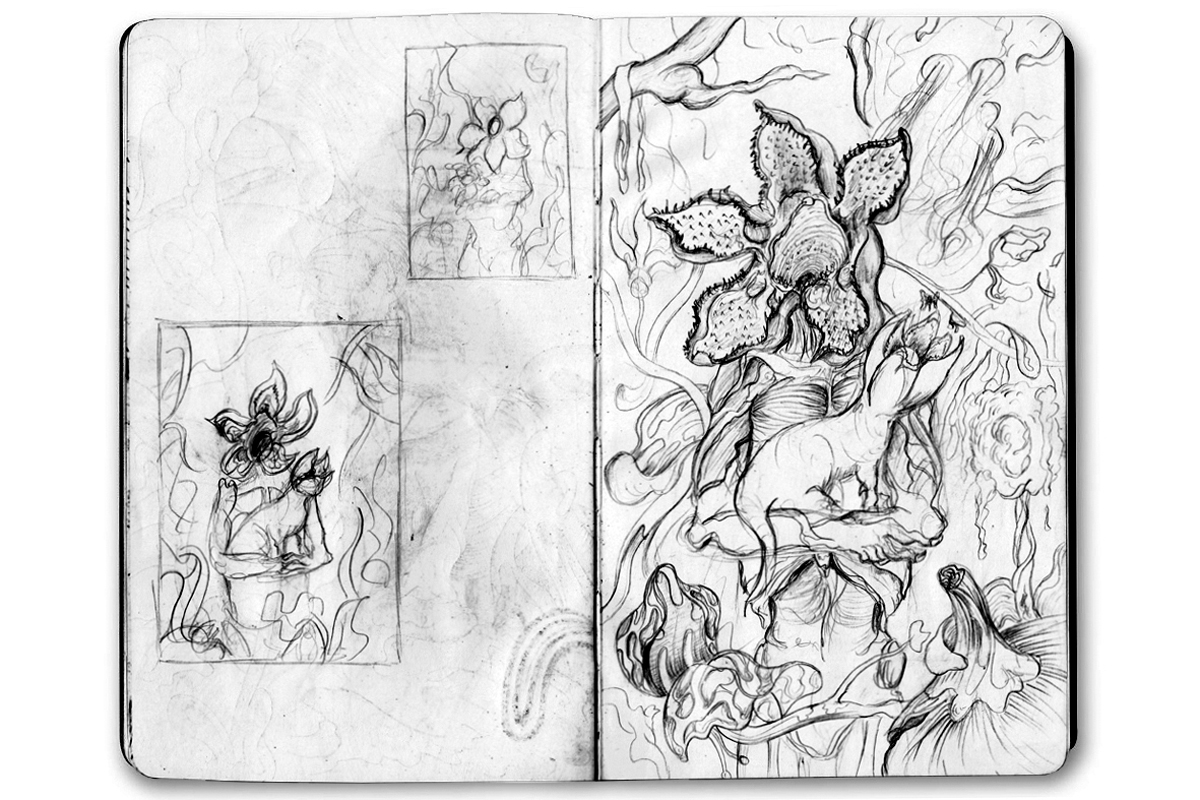
MURUGIAH’s finished charcoal drawing, scanned and colored digitally, appears in the new Stranger Things book out in mid-October. Illustration by MURUGIAH
Did it take you awhile to find yourself or feel comfortable as an illustrator?
The interests were always there, but it was very much a case of the time it takes to really discover the things you want to explore. It’s such a cliche, but everyone says it takes a few years to find your feet, and it really does. I spent the last four years in this old style and then converging onto this new style, doing jobs that were all over the place, and only now in this last year has everything I’ve done had a link to this new style.
[rp4wp]
How much time do you spend actually creating these days versus, say, marketing yourself?
I have a quite strict working schedule because again, the downsides of strict Asian parents I mentioned before, but the upside is they’re very hardworking, and I’ve adopted some of those hardworking skill sets. I spend the first two hours of the day looking at various companies and collaborators and showing interest, getting in contact, explaining who I am and showcasing what I do, and then I spend the rest of the day into the evening drawing, painting, and working out ideas in my sketchbook—like all of the time. The style I’ve chosen is quite detailed; it requires a lot of hours at the desk churning stuff out, so I’ve always got ideas in my sketchbook. I have a list here of eight personal products to be getting on with. Once those eight are done I’ll have another eight or nine.
This article originally appeared in the Fall/Winter 2019 issue of Sixtysix with the headline “MURUGIAH.” Subscribe today.
